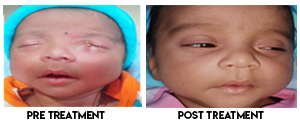Watering eyes management

Blocked tear ducts are common among babies. Most blocked tear ducts will get better on their own, and others will generally respond well to treatment.
The American Academy of Ophthalmology report that as many as 20 percent of babies are born with a blocked tear duct, which is also called a nasolacrimal obstruction.
- Excessive tearing
- A swollen pool of tears below the eyes, known as a lacrimal lake
- Discharge from the eyes
- Crusty eyes or eyelashes after sleeping.
- A bump near the corner of the eye
- Swelling, soreness, or tenderness near the nose
Doctors look for the following signs to make a diagnosis:
The majority of blocked tear ducts resolve within
the first year of the baby's life.
As a result, doctors tend to recommend conservative treatment only. This should clear 90 percent of tear duct blockages.
As a result, doctors tend to recommend conservative treatment only. This should clear 90 percent of tear duct blockages.
Conservative treatment methods
Invasive treatment : Syringing and Probing
- Doctors suggest massaging the tear sac. This forces fluid through the tear ducts which can remove the blockages.
- They may also prescribe antibiotic eye drops if the baby's eyes are producing a lot of discharge, but this will not fix the underlying problem.
Invasive treatment : Syringing and Probing


